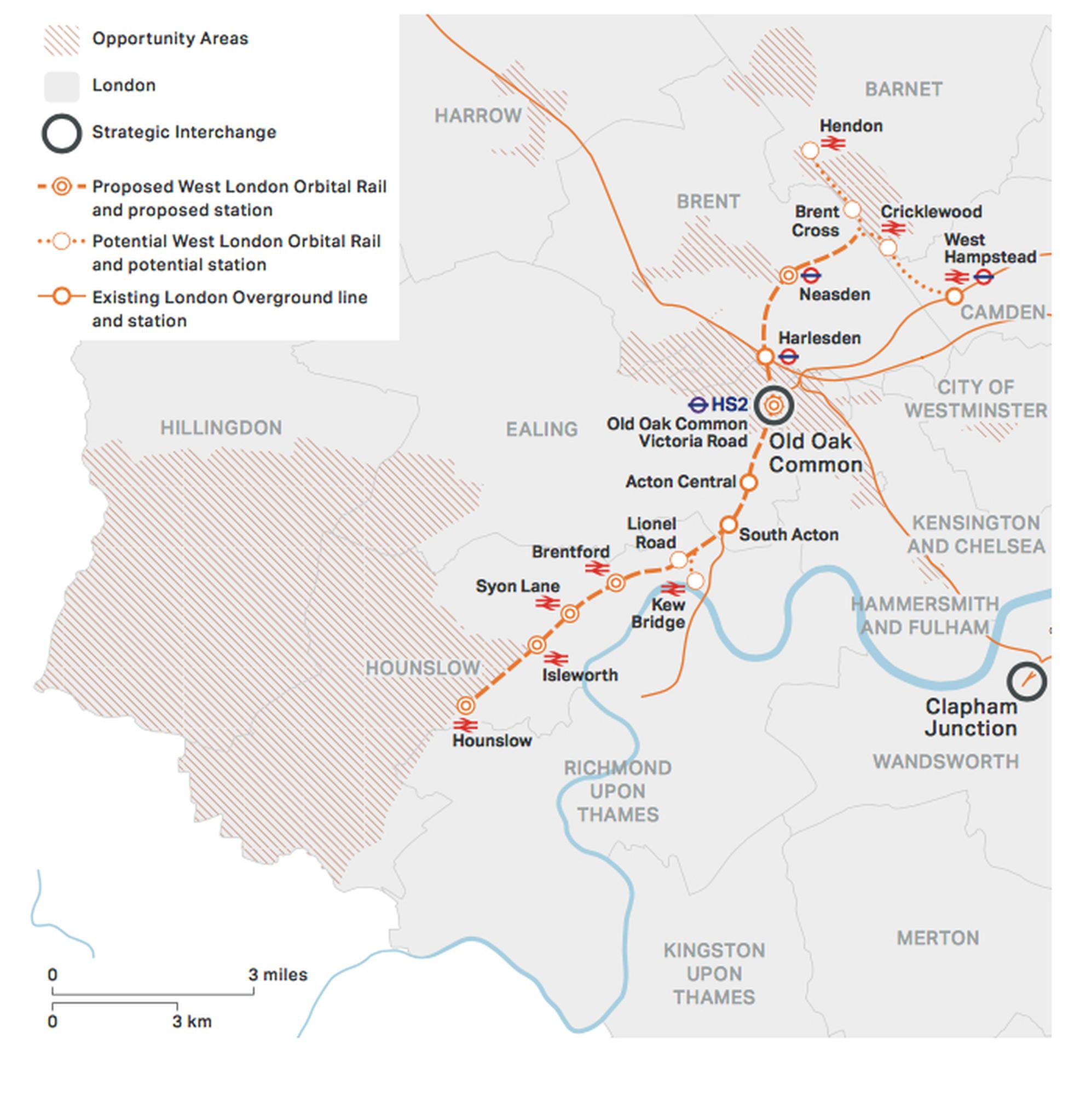

Plans for a West London Orbital rail line - connecting Hounslow, Hendon and Cricklewood - feature in the Mayor of London’s Transport Strategy. Mayor Sadiq Khan’s transport vision for the next 25 years was presented today to the London Assembly ahead of its final publication next month.
The proposed West London Orbital Line, linking up London Overground services, would run via Brent Cross, Old Oak Common, Neasden, Brentford and Isleworth (pictured top left). “Most Londoners want to move around London – rather than in and out of the centre – every day, and the London Overground supports this type of travel,” states the strategy. “London Overground train service improvements are therefore needed to support new jobs and housing throughout inner London and parts.” The new West London Orbital line has the potential to support the delivery of an additional 20,000 homes, as well as employment growth in west London, according to the strategy.
Also proposed is a new tramline from South Wimbledon to Sutton (pictured bottom left), currently being considered by TfL and the London Boroughs of Merton and Sutton. The extension would pave the way for 10,000 new homes as well as new jobs in the area. “Sutton town centre is a focus for many of these new homes. The tram extension would also increase the number of jobs accessible to local residents by providing faster, more frequent connections to centres of employment.
“In the longer term, a further extension beyond Sutton town centre to the planned London Cancer Hub at Belmont, which may accommodate up to 10,000 new jobs, will also be considered to support the full development of the site. Trams could also run direct from Sutton to Wimbledon, linking to Crossrail 2 and delivering a wider improvement in connectivity in south west London.”
The strategy supports measures to discourage non-essential car and freight trips, especially shorter trips. For example, it calls on boroughs to consider local road user charges or workplace parking levies.
Parking policy changes, such as introducing or extending controlled parking zones, or incentives to residents to give up parking spaces could also help discourage car use, it suggests. “Higher parking charges for the most polluting cars could additionally help encourage the use of cleaner vehicles.”
The mayor pledges investment for new crossings for people walking and cycling to connect communities and encourage healthier lifestyles. Plans have been drawn up for a new walking and cycling crossing between Rotherhithe and Canary Wharf, which “would give thousands of people a direct link between Canada Water and Canary Wharf, and support jobs and new homes in the area”.
The Mayor’s Transport Strategy sets out Sadiq Khan’s aim for 80% of trips in London to be made on foot, by cycle or using public transport by 2041.
Khan said: “I’ve been clear that we need to be bold in how our city operates as London’s population grows, and this means not only investing record amounts in new infrastructure like extensions to the tube, rail and Crossrail 2, but working with boroughs and local communities to reduce our reliance on car use across London.
“With our unprecedented focus on walking, cycling and clean public transport, our ambitious Transport Strategy can act as a crucial driver for new homes and jobs, but also improve quality of life for everyone living in London.”
During last year’s statutory consultation on the draft Mayor's Transport Strategy, more than 6,500 responses were received from members of the public and stakeholders from across the UK.
The Mayor’s Transport Strategy will be discussed by the London Assembly on 8 March and can be accessed by visiting:
https://www.london.gov.uk/moderngov/ieListDocuments.aspx?CId=179&MId=6259
The 320-page strategy offers details of:
TransportXtra is part of Landor LINKS
© 2026 TransportXtra | Landor LINKS Ltd | All Rights Reserved
Subscriptions, Magazines & Online Access Enquires
[Frequently Asked Questions]
Email: subs.ltt@landor.co.uk | Tel: +44 (0) 20 7091 7959
Shop & Accounts Enquires
Email: accounts@landor.co.uk | Tel: +44 (0) 20 7091 7855
Advertising Sales & Recruitment Enquires
Email: daniel@landor.co.uk | Tel: +44 (0) 20 7091 7861
Events & Conference Enquires
Email: conferences@landor.co.uk | Tel: +44 (0) 20 7091 7865
Press Releases & Editorial Enquires
Email: info@transportxtra.com | Tel: +44 (0) 20 7091 7875
Privacy Policy | Terms and Conditions | Advertise
Web design london by Brainiac Media 2020